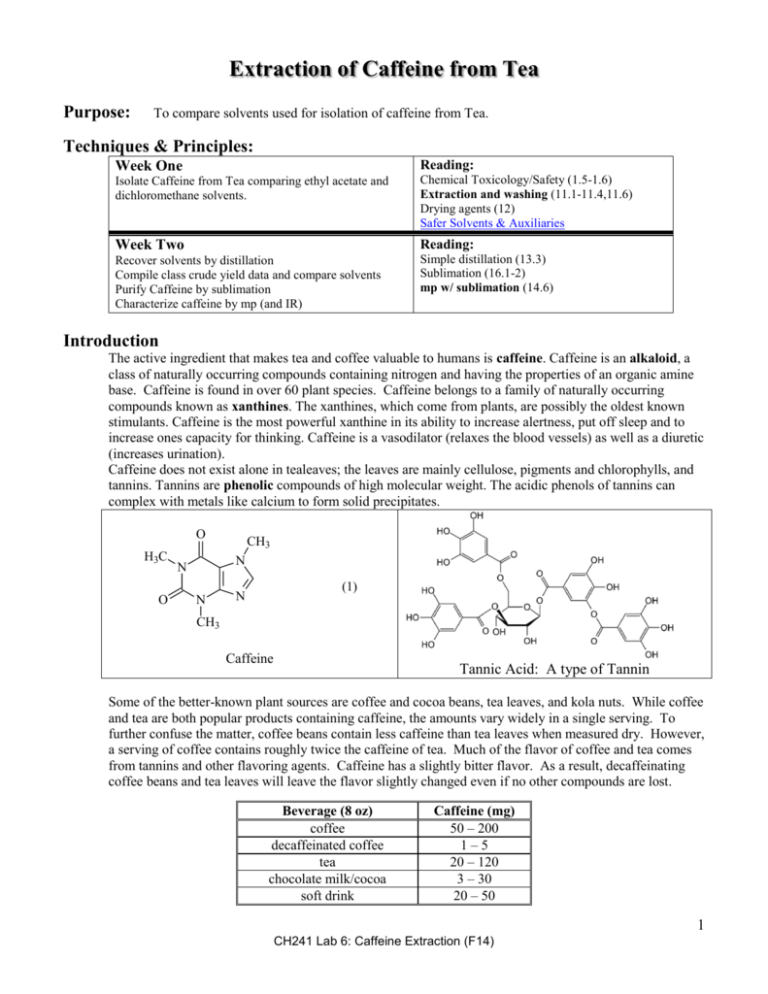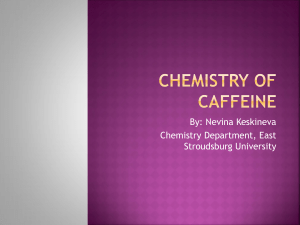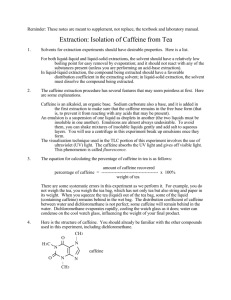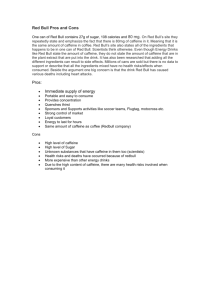Extraction of Caffeine From
advertisement

Extraction of Caffeine from Tea Purpose: To compare solvents used for isolation of caffeine from Tea. Techniques & Principles: Week One Reading: Isolate Caffeine from Tea comparing ethyl acetate and dichloromethane solvents. Chemical Toxicology/Safety (1.5-1.6) Extraction and washing (11.1-11.4,11.6) Drying agents (12) Safer Solvents & Auxiliaries Week Two Reading: Recover solvents by distillation Compile class crude yield data and compare solvents Purify Caffeine by sublimation Characterize caffeine by mp (and IR) Simple distillation (13.3) Sublimation (16.1-2) mp w/ sublimation (14.6) Introduction The active ingredient that makes tea and coffee valuable to humans is caffeine. Caffeine is an alkaloid, a class of naturally occurring compounds containing nitrogen and having the properties of an organic amine base. Caffeine is found in over 60 plant species. Caffeine belongs to a family of naturally occurring compounds known as xanthines. The xanthines, which come from plants, are possibly the oldest known stimulants. Caffeine is the most powerful xanthine in its ability to increase alertness, put off sleep and to increase ones capacity for thinking. Caffeine is a vasodilator (relaxes the blood vessels) as well as a diuretic (increases urination). Caffeine does not exist alone in tealeaves; the leaves are mainly cellulose, pigments and chlorophylls, and tannins. Tannins are phenolic compounds of high molecular weight. The acidic phenols of tannins can complex with metals like calcium to form solid precipitates. O H3C O CH3 N N N (1) N CH3 Caffeine Tannic Acid: A type of Tannin Some of the better-known plant sources are coffee and cocoa beans, tea leaves, and kola nuts. While coffee and tea are both popular products containing caffeine, the amounts vary widely in a single serving. To further confuse the matter, coffee beans contain less caffeine than tea leaves when measured dry. However, a serving of coffee contains roughly twice the caffeine of tea. Much of the flavor of coffee and tea comes from tannins and other flavoring agents. Caffeine has a slightly bitter flavor. As a result, decaffeinating coffee beans and tea leaves will leave the flavor slightly changed even if no other compounds are lost. Beverage (8 oz) coffee decaffeinated coffee tea chocolate milk/cocoa soft drink Caffeine (mg) 50 – 200 1–5 20 – 120 3 – 30 20 – 50 1 CH241 Lab 6: Caffeine Extraction (F14) Several health concerns have been raised over the consumption of caffeine. The Food and Drug Administration (FDA) has extensively studied the consumption of caffeine and its health effects. In 1987 the FDA concluded that normal caffeine consumption does not increase risk to health. These studies included cancer risk, coronary heart disease, osteoporosis, reproductive function, birth defects, and behavior of children. Many consumers prefer to avoid caffeine partially or altogether due to its stimulant effects and others still have health concerns. This makes decaffeination of coffee and tea an important industrial process. Decaffeination is also significant for the world’s economy; approximately eight billion pounds of coffee are grown a year making it second only to oil as an international commodity. It should be noted that decaffeinated coffee and tea are not caffeine free. These products can be labeled decaffeinated as long as 97% of the caffeine has been removed. Greening the Chemistry The industrial decaffeination process has evolved over the years. Initially direct contact methods used chloroform (CHCl3), and more recently methylene chloride (CH2Cl2), as the solvent to repeatedly rinse the green (unroasted) coffee beans that had been softened by steam. Once sufficient caffeine had been removed, the beans would be roasted. Since these organic solvents have a high vapor pressure and low boiling point, any solvent remaining in the beans is removed during roasting. This method has several brown characteristics. Both of these solvents are carcinogenic and have several human health concerns with methylene chloride having the lesser overall hazard. Chlorinated hydrocarbon waste has significant environmental impacts and is costly to dispose. Roasting also does not guarantee full removal of the solvent, although solvent levels are rarely detectable. So why were these solvents used in the first place? Their advantages are that they are not water-soluble, have a low boiling point, and remove caffeine without removing significant amounts of other compounds, leaving the majority of the flavor unaltered. Recently the direct contact process has been greened significantly using supercritical CO2. The green coffee beans are steam softened with water and then supercritical CO2 is used to extract the caffeine. Once the system is returned to room temperature and pressure the coffee beans and separated caffeine are now solvent free as CO2 returns to the gas phase. Then the CO2 can be captured and reused. This method has all the advantages of the above technique without the environmental and human health risks. Indirect contact methods have also been developed to decaffeinate coffee. The green coffee beans are soaked (steeped) in almost boiling water until the caffeine is removed from the bean. The coffee solution is then treated with ethyl acetate (a natural ester) which has moderate human health hazards but is not carcinogenic. Ethyl acetate solvates caffeine more effectively than water and extracts the caffeine. The remaining ethyl acetate is removed from the coffee solution by steaming. The coffee solution is then combined with the beans which reabsorb the coffee oils as they are dried. The procedure we will be using with this experiment is also an indirect method for extracting caffeine from coffee. We will be comparing the efficiency and “greenness” of ethyl acetate and dichloromethane as extraction solvents. We will also be separating the solvent from our crude product by distillation. The distilled solvent will be collected and stored for reuse next year. Theory/Discussion Caffeine (C8H10N4O2) is an alkaloid. Alkaloids are bitter tasting, natural nitrogen-containing compounds found in plants. Alkaloids are often found to have potent physiological activity. Some better known examples are morphine, heroin, lysergic acid (LSD), cocaine, quinine, strychnine, and nicotine. 2 CH241 Lab 6: Caffeine Extraction (F14) The basic property of alkaloids come from the lone pair of electrons found on at least one nitrogen. The basic N in caffeine can be used to increase or decrease its water solubility. Acidic conditions will form the conjugate acid salt giving caffeine increased water solubility as a cation. On the other hand if caffeine is in a basic environment it takes the neutral form and is only somewhat polar. O H3C O CH3 N N Acid H3O N N O H3C O OH Base CH3 More soluble in Nonpolar Solvents CH3 N N N CH3 N H More soluble in water In order to successfully extract any substance from one solvent into another, we must maximize differences in solubility. In some situations choosing a green process means trading some efficiency for human and environmental health. While 1-propanol or ethyl acetate may be a less efficient extractor than CHCl3 and CH2Cl2, we can maximize our efficiency by using a few simple techniques. 1. Adding NaCl to the caffeine in water solution: a. The water will be more attracted to the very polar NaCl and less attracted to caffeine thus “salting out” the caffeine from water solution. 2. Adding Ca(OH)2 or CaCO3 to a caffeine in water solution: a. This makes the solution basic so puts caffeine in its least polar form and so more readily solvated in organic solvents and less attracted to water. b. The water solution contains much more than just caffeine, and some of these compounds are also soluble in organic solvents. Basic Ca(OH)2 reacts with tannic acids to form insoluble tannin salts which precipitate and so can be removed from the solution before the caffeine is extracted. The organic extract will primarily contain caffeine with small amounts of impurities. This solution is washed with 10% NaOH to remove impurities. Caffeine is also water soluble, but by keeping the washing solution basic it minimizes the caffeine lost, while maximizing the removal of impurities. The extraction is analyzed by determining the partition coefficient (KP) (also known as the partition constant, partition ratio, distribution coefficient (Kd) or distribution ratio) KP solubilityin extractant solubilityin source solution (3) where solubility is usually given in g/mL. Partition functions with larger values result in more efficient extractions. Extractions are most effective when repeated several times with small volumes of solvent rather than once with a large volume. 3 CH241 Lab 6: Caffeine Extraction (F14) Procedures: Notes: Part 1:Extraction of Caffeine The washings should be repeated a total of three times. The final washing may need to be filtered to recover all the extract. 1. Heat about 200.0 mL of distilled water to boiling. 2. Weigh about 10-12 grams (about 5 bags) of tea leaves into a large beaker. Record the actual mass used. 3. Pour 100 mLs of the boiling water over the tea leaves. Cover with a watch glass and allow the solution to steep for 7-10 minutes. 4. Pour the tea solution through cheesecloth into another beaker and press out as much of the water in the tea leaves as possible. Set the extracted solution aside. 5. Put the leaves from the cheesecloth back into the beaker and repeat the tea extraction twice more with 25 mL of boiling water, letting stand for five minutes, pouring through the cheese cloth and pressing out as much water as possible each time. Combine each of the washings with the initially extracted solution.1 1 2 To “salt out” the caffeine since water will be more attracted to the NaCl than it will be to the caffeine making the amount of caffeine in the water less. 3 The Ca(OH)2 will react with the tannins in the tea to precipitate them as Calcium salts. Sometimes Calcium Carbonate is used. Calcium hydroxide also makes the solution basic. 4 6. To the combined extracts add approximately 20 g of sodium chloride2 and about 1 gram total of calcium hydroxide. 3 7. Heat and stir the solution for 15 minutes (near boiling).4 8. Vacuum filter the hot solution through a Buchner funnel to remove any undissolved solids. Cool the solution to room temperature. 9. Pour the tea extract into a separatory funnel supported in an iron ring and extract5 with 4 successive 25 mL portions of extraction solvent (1-propanol, dichloromethane or ethyl acetate). 6 10. Combine the organic extracts in a separatory funnel and wash once with 25 mL of 10% aqueous NaOH solution. 11. Transfer the extract solution into an Erlenmeyer flask and dry by adding about 2-3 grams of anhydrous magnesium sulfate or sodium sulfate and swirling occasionally until it no longer clumps. This process will enable the salt to dissolve and more of the tannins to precipitate. 5 Mix the solutions gently to minimize emulsion formation and vent the separatory funnel frequently, especially during initial mixing to avoid pressure buildup. Make sure any emulsion layer has mostly disappeared before separating. 6 1-propanol or ethyl acetate will be top layers; dichloromethane will form a bottom layer. If a layer is not clearly visible, add an additional portion (10-25 mLs) of solvent to the separatory funnel. Stir gently with a stirring rod to break up any emulsion. 12. Decant (or filter) the dried extract into a 250 mL round bottom flask (RBF) and add a few boiling chips to be ready for distillation. 13. Continue on to Part 2 or this is an appropriate stopping place if you are out of time. Stopper your RBF and place on a cork support in your laboratory drawer for next week. 4 CH241 Lab 6: Caffeine Extraction (F14) Part 2: Purification of Caffeine 7 The boiling point of 1-Propanol is 97-98oC Ethyl acetate is 77.1oC Dichloromethane is 39.6oC 14. Prepare a simple distillation apparatus. 15. Distill the extraction solvent (either 1-propanol, ethyl acetate, or dichloromethane) from the caffeine extract using a water bath as a heat source. Carefully monitor the temperature so as not to overheat the caffeine and so that only the extraction solvent is distilled. 7 8 Stop the distillation (remove from the hot water bath) before the flask is dry when either the vapor temperature drops and no more distillate is being collected in the receiving flask or when the temperature exceeds the boiling point of the solvent by more than 5C. 9 16. Stop the distillation (remove the heat source) just before the flask is dry. 8 17. Take your distilled solvent and measure the volume (accurate to 1 mL), and add it to the corresponding recycled solvent collection container. 9 The recovered solvents will be used next year for this experiment. 10 Crude caffeine should be a light tan color and only turns dark brown when degraded due to high heat. 11 . Alternately the crude caffeine could be put into a preweighed filter flask to be ready for sublimation under reduced pressure (vacuum) Vacuum Sublimation apparatus: 18. Rinse the crude caffeine10 residue in the flask with a couple small portions of acetone into a pre-weighed (tared) glass Petri dish11 and evaporate the acetone using a low heat or a stream of air. 19. Determine the mass of the crude caffeine. 20. Purify your caffeine by sublimation at atmospheric pressure12, carefully monitoring the heat so as to minimize the decomposition of your caffeine. 12 Atmospheric Sublimation apparatus 21. Determine the mass of the pure product and the melting point. 13 22. Use the FT-IR to identify your product as caffeine. Caffeine 13 Caffeine will sublime during melting so the melting point must be taken in a sealed tube. Written Report: For this experiment create a formal report following the formal report guidelines given. Besides the overall process the report should include a specific evaluation of greenness including comparison of solvents used. When determining Percent yield of caffeine from original sample assume that the maximum mg of caffeine is in solution before extraction. (Note that 1 oz = 29.57 mL) References: Murray, D.S.; Hansen, P.J., J. Chem. Educ., 1995 (72) 851. Hampp, A., J. Chem. Educ., 1996 (73) 1172. Hill,Barbaro; Experiments in Organic Chemistry CPC 2000 John Thompson; Lane Community College, Carol Handy PCC 5 CH241 Lab 6: Caffeine Extraction (F14) 6 CH241 Lab 6: Caffeine Extraction (F14) CH241 Lab 6: Caffeine Extraction: Name______________ Pre Lab Exercises Week 1: 1. What two things does the addition of Ca(OH)2 do to aid the extraction of caffeine. Explain what and why. A. B. 2. Explain why salt (sodium chloride) is added to the water before the caffeine is extracted with solvent. What is happening? Why? How? 3. You have a solution of 600 mg of caffeine dissolved in 100 mL of water. The partition coefficient for aqueous caffeine extracted with Dichloromethane (CH2Cl2) is 4.6. Show all calculations for the following: a. How many mgs caffeine would be extracted from the 100 mL of water containing 600 mg of caffeine with one portion of 60 mL of dichloromethane? b. How many mgs caffeine would be extracted from the 100 mL of water containing 600 mg of caffeine with two 30 mL portions of dichloromethane? c. How many mgs caffeine would be extracted from the 100 mL of water containing 600 mg of caffeine with three 20 mL portions of dichloromethane? 4. Consider the chemicals used for this experiment (MSDS sheets found online). What realistic hazards are present? What safety procedures are necessary beyond wearing goggles and gloves? 7 CH241 Lab 6: Caffeine Extraction (F14) 5. Recreate and complete the following tables of chemical data in your laboratory notebook: Structure Solids Solubility Crystal form & color m.p. C in Water @ 25oC Caffeine in Water @ 100oC Density Liquids Solubility in Water Dipole Moment b.p. C When mixed with water this liquid will be the top or bottom layer? Ethyl acetate Dichloromethane 8 CH241 Lab 6: Caffeine Extraction (F14) CH241 Lab 6: Caffeine Extraction: Name______________ Pre Lab Exercises Week 2: 1. Assume that substance “C” has a distribution coefficient (Kd) of 4.6 between methylene chloride and water. If 52 mg of “C” are added to a vial containing 2 mL of water and 2 mL of methylene chloride, how many mg “C” would be in each layer after the mixture had been mixed thoroughly? 2. Suggest a reason why caffeine is much less soluble in a solvent such as hexane than in dichloromethane. 3. Explain why four extractions using 25mL of solvent is more effective than one extraction using 100 mL. 4. Why do we add solid anhydrous MgSO4 or Na2SO4 to an extracted caffeine solution? B. What is the MgSO4 or Na2SO4 doing chemically? 5. Explain how sublimation is used to purify caffeine. Draw a typical apparatus for performing a sublimation: A. Under vacuum (reduced pressure) B. At atmospheric pressure. 6. How does one take a melting point of a sublimable solid? 9 CH241 Lab 6: Caffeine Extraction (F14)






